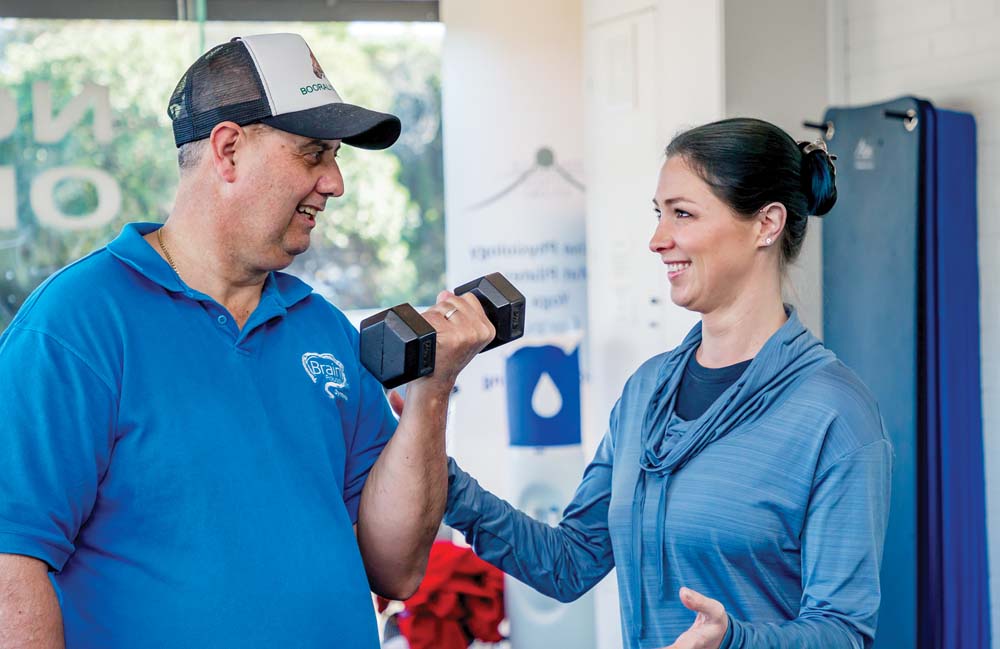
WHEN Dave Smith crosses the finish line in the Dystonia Walk next month he will have his two daughters beside him and friends and supporters out in front to welcome him home.
The Dystonia sufferer is training hard to compete in the 21.1km Melbourne Half Marathon, Sunday 14 October, to raise awareness for sufferers of the disease which has ravaged his body for the past three years.
“Having run the full marathon in 1983 from Frankston to the Arts Centre in Melbourne I knew this would become my next goal,” he said.
After being diagnosed in March 2015 and undergoing deep brain stimulation surgery in April last year, Mr Smith is helping to raise funds for the Brain Foundation for research purposes.
Dystonia is a neurological movement disorder that causes muscles in the body to contract or spasm involuntarily, causing twisting, repetitive and patterned movements as well as abnormal postures.
Known as the “disorder you just can’t shake off”, Dystonia is not a single disease but a syndrome – a set of symptoms that cannot be attributed to a single cause but share common elements. It can affect a specific body area, such as the neck, face, jaw, eyes, limbs or vocal cords.
The condition is debilitating and taxing on the body – especially on sleep. Mr Smith said early on he could not get a good night’s rest because his hands were shaking. “I would wake up every 15-30 minutes thinking someone was touching my face but it was me making the sheets move,” he said.
The sleepless nights led to fatigue and a lack of energy. A keen walker, Mr Smith said exercise was the key as it “helped me gain some sleep as I am not into taking pills or tablets”.
Dystonia in both Mr Smith’s arms can be traced back to birth. No other member of his family has it. “It causes problems in everyday life, like tying my shoelaces, starting my car as I am left handed, shaving and dressing myself – buttons are difficult as is putting on a tie,” he said.
“Even cutting my toenails was difficult. I had to find shortcuts or tricks to help me do things everyone can do, like only having small drinks as I would spill a normal cup of coffee or tea. A travel mug with a lid was the answer.
“Shaving was out until my son brought me an electric razor. I write using a thick pen, have fatter grips on my knife and fork, use elastic shoe laces and visit a podiatrist for my toenail issue.”
Botox injections helped as temporary muscle relief, but deep brain stimulation helped reduce the tremors more permanently. The neurosurgical procedure involved implanting a stimulator in the brain to send electrical impulses through implanted electrodes to specific targets in the brain to treat movement and neuropsychiatric disorders.
He said the stimulation to select brain regions also provided therapeutic benefits for other treatment-resistant disorders, such as Parkinson’s disease, essential tremor and dystonia.
“In this procedure doctors drill two holes into your skull and implant electrodes into your brain. You have to be awake, so the doctors can see if it is effective; the joy for me was it stopped the shakes completely during the operation,” Mr Smith said.
“The second part of the stimulation was to insert the stimulator into my chest with leads running up into my brain (thankfully I was asleep for this one). Once hooked up the following day the neurologist came in and turned on my system and, yes, it stopped the shaking.”
Unable to drive afterwards the finance and administration manager was off work for six months and now works five hours on Mondays, Tuesdays Thursdays and Fridays. He is still unable to write – the result of his brain and hand “not connecting”. “When I try to put pen to paper the shakes do not allow me to write,” Mr Smith said.
“Fortunately, I can still type and use the mouse but I do get very tired in the arms afterwards. Getting back to work was another important step in my rehabilitation from this disorder.”
On Wednesdays he attends the Living Longer, Living Stronger classes at Pinnacle Health, Dromana. Personal trainer Carley Milton guides the class through a series of exercises, including light weights, exercise bike and rowing machine. “The aim is to keep the body active which, in turn, helps the mind – and being around like-minded people helps in the recovery and we have a bit of fun.”
Each month he visits The Private Sea flotation clinic to allow his aching muscles – the arms in particular – to relax, insuring a better night’s sleep.
Mr Smith has raised $1766 so far but is “hoping to get to $21,000 by 14 October” to aid the non-government funded Brain Foundation.
“Something I am very passionate about is trying to help find a cure for this disorder,” Mr Smith said.
“Family have been my biggest supporters and I thank each and every one of them. When dealt a situation like mine you need all the support you can get. I am grateful also to friends and work colleagues, and to my local doctor and the staff at Monash Medical Centre, Clayton.”
Dystonia can affect adults like David or children. By raising awareness of this painful and debilitating condition it is hoped more support will lead to new treatments and research for a cure.
“I hope to be able to help at least one person in the future that may suffer from Dystonia Disorder in as much that they are aware that there are groups like the Australian Dystonia Support Group that you can reach out to for support. If anyone can help by donating to my walk it would be much appreciated, especially by the Brain Foundation.”
Details: melbournemarathon2018.everydayhero.com/au/dave-s-dystonia-walk
First published in the Southern Peninsula News – 11 September 2018



